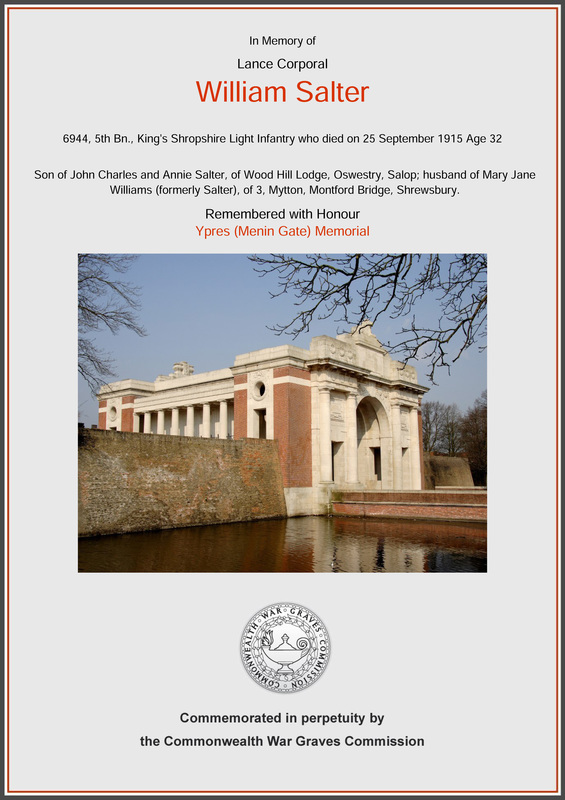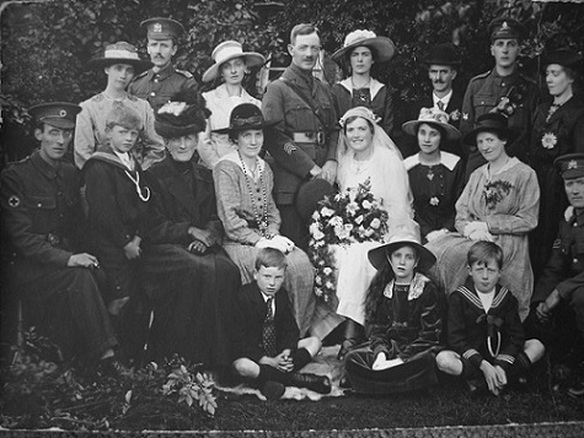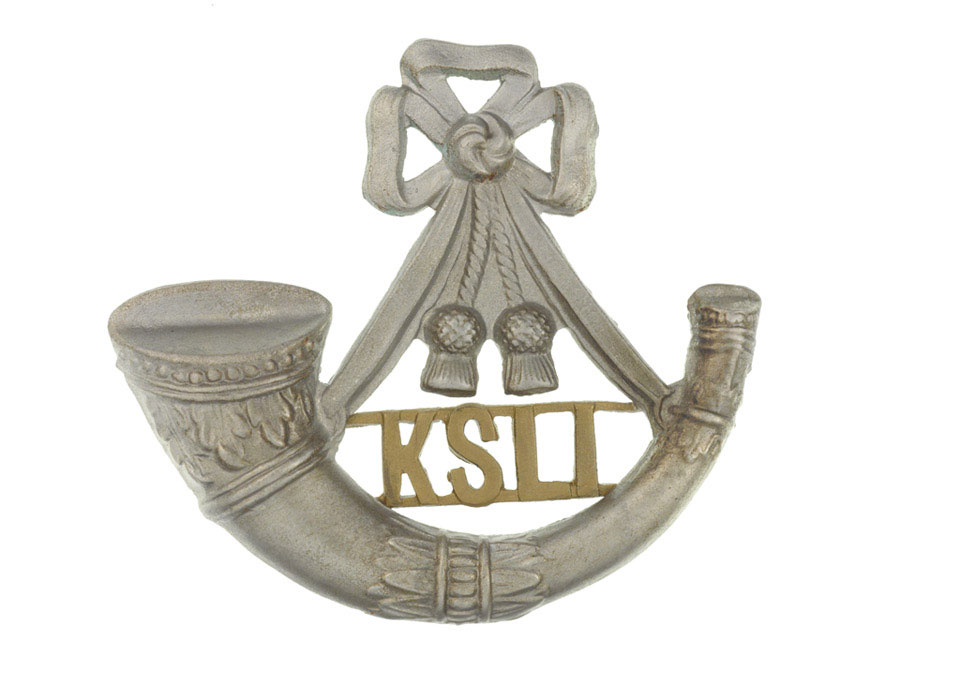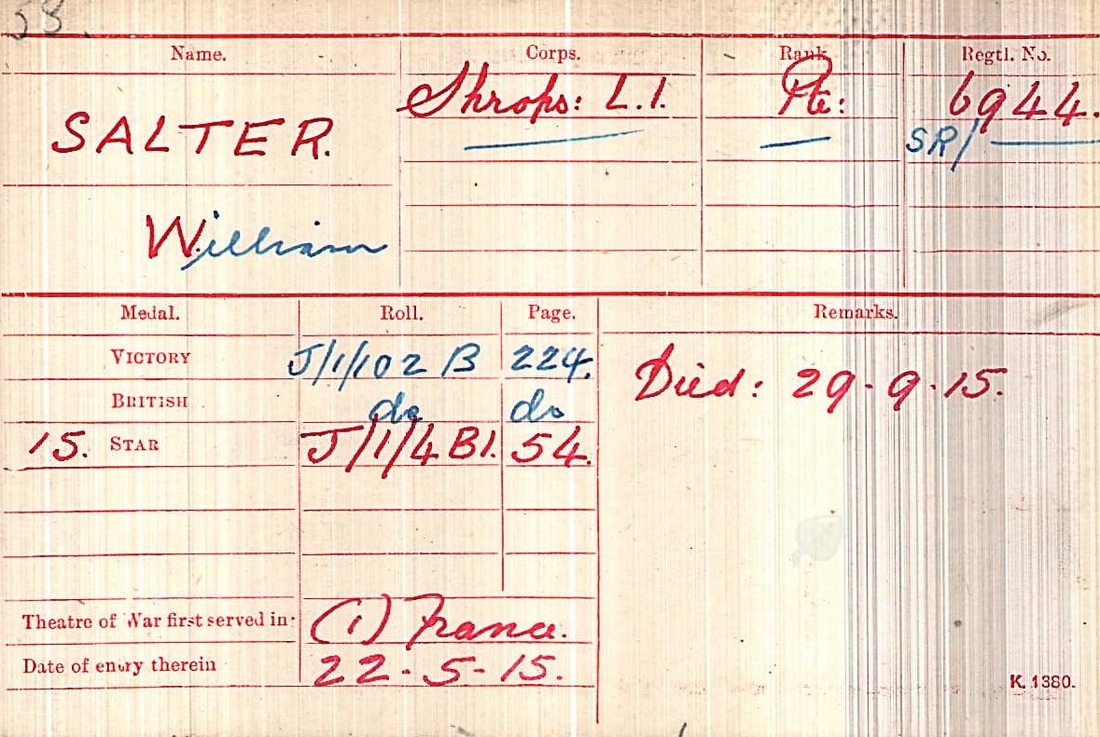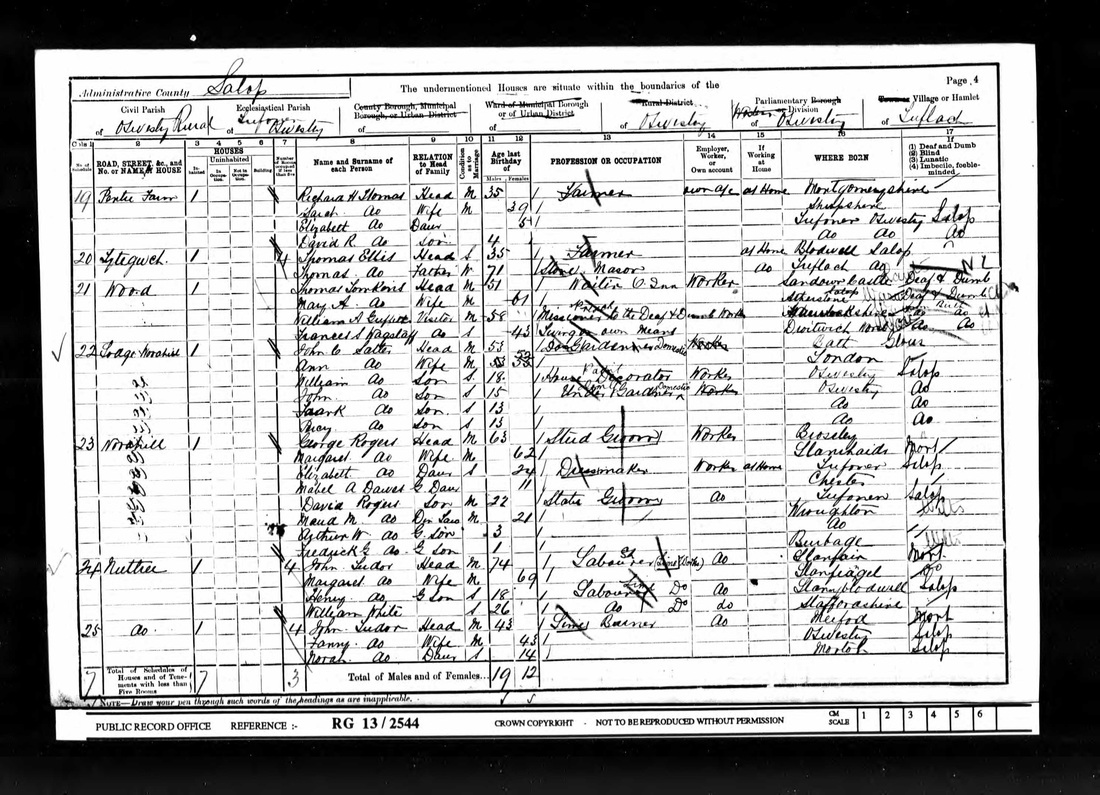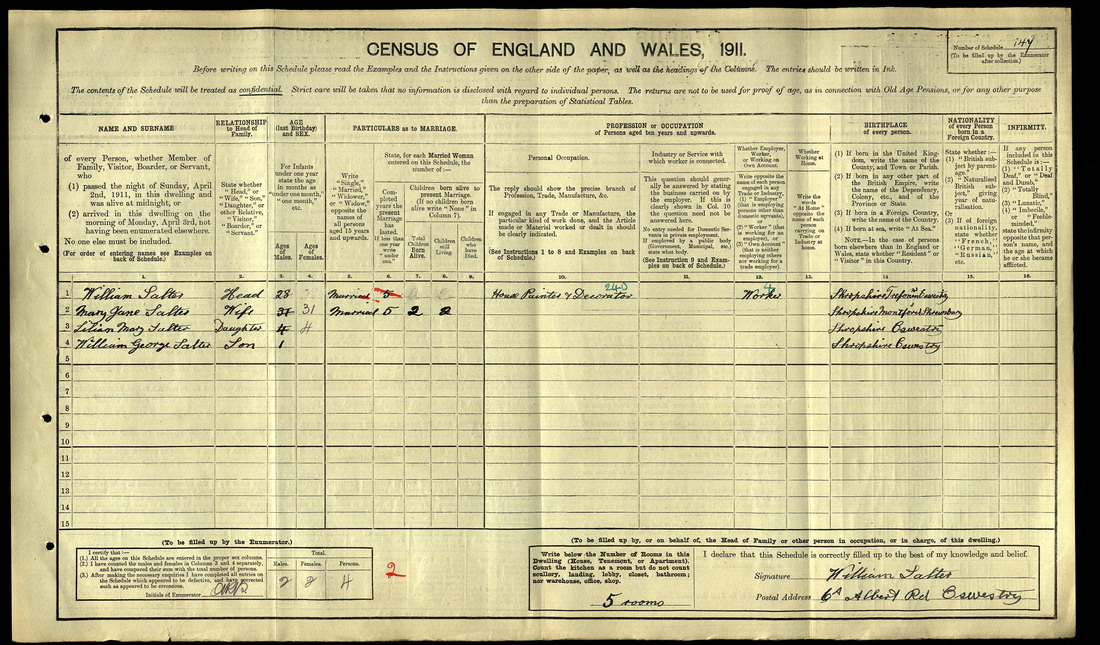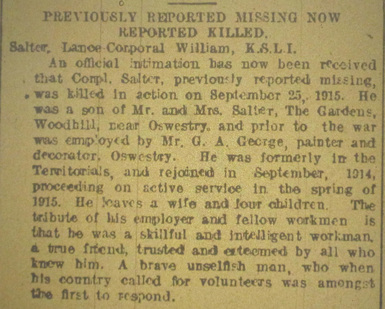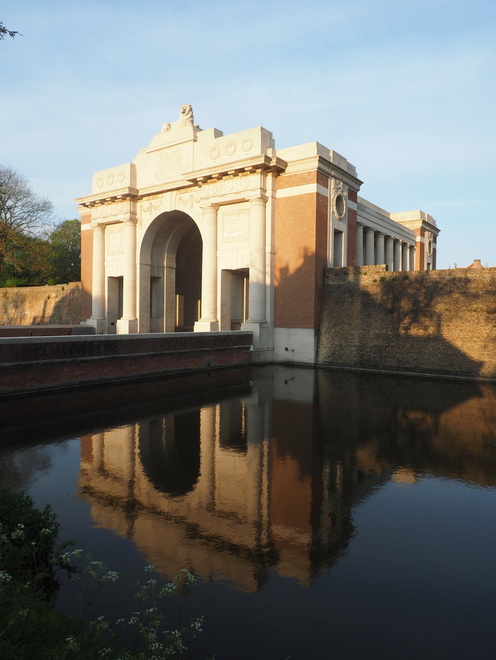William Salter
|
Introduction
William Salter was the eldest of four sons born to John Charles Salter and his wife Annie. John Charles had originated from Bath and his wife from London but it would seem that in 1901 the family were all living at Wood Hill Lodge with William's father and a younger brother John employed as gardeners, with the younger Frank and Percy still at school. William himself aged 18 was employed as a painter and decorator by G. A. George of Oswestry. William Salter married Mary Jane Davies from nr Shrewsbury in 1906 and by 1911 they were living in Albert Rd, Oswestry with 2 children. William was still employed as a painter decorator. |
William had been a member of the Territorials well before the war and immediately re-joined as soon as war broke out. Two of his brothers also signed up and the report below is from the Llangollen Advertizer (22/2/1918) recording information about the brothers at that time.
"Sergt Frank Salter, Royal Welsh Fusiliers, son of Mr & Mrs Salter, Woodhill Lodge, Oswestry has been given a commission on the field in Palestine in recognition of his gallant and distinguished services rendered during the recent occupation of Gaza. He was educated at Trefonen School and prior to enlistment in the early months of the war was employed as a gardener at Leighton Hall, Welshpool. He went with his regiment to Egypt and served through the Suvla Bay landing unhurt. His brother Lance Corporal William Salter has been killed in action and Private Percy Salter is in training in England"
During my research I also discovered this picture of Sergeant Frank Salters wedding in 1918 (see below)
"Sergt Frank Salter, Royal Welsh Fusiliers, son of Mr & Mrs Salter, Woodhill Lodge, Oswestry has been given a commission on the field in Palestine in recognition of his gallant and distinguished services rendered during the recent occupation of Gaza. He was educated at Trefonen School and prior to enlistment in the early months of the war was employed as a gardener at Leighton Hall, Welshpool. He went with his regiment to Egypt and served through the Suvla Bay landing unhurt. His brother Lance Corporal William Salter has been killed in action and Private Percy Salter is in training in England"
During my research I also discovered this picture of Sergeant Frank Salters wedding in 1918 (see below)
Military Record including Regimental and Battalion Information
|
William Salter enlisted in Shrewsbury into Special Reserve on or around the 24th August 1914.
He joined the 5th Battalion Kings Shropshire Light Infantry. A war-raised Service Battalion, formed in Shrewsbury in August 1914 under Lt. Col. H. M. Smith, from the mass of enthusiastic volunteers coming forward to enlist. Posted to the 42nd Brigade, 14th Division. After training around Aldershot, it landed at Boulogne on 20th May 1915, first coming under fire at Ypres on 31st May 1915, and then served entirely on the Western Front. |
It can be seen from William Salters Medal Roll Index Card below that he landed in France on the 22nd May 1915 and within days they were on the frontline close to Ypres. Whilst his record below shows his death as the 29th it is known he was actually killed on the 25th which was to be one of the worst days in the history of the 5th Battalion KSLI.
The following extract is taken from an account by Annette Burgoyne on the www.facebook.com/KSLI.Battlefields.tours/ site
25th September 1915
The 5th Battalion King's Shropshire Light Infantry-"A" Coy -H.13 & H.14, "D" Coy H.15a & H.16a, "B" Coy in support in S.15, "C" Coy also in S.15 ?:-
3.50 a.m. intense British Bombardment starts, to which the Germans reply.
The men move into their assault positions, "A" and "D" Companies and 2 machine guns and the signallers move into "No Man's Land" just beyond H.15, "A" on right "D" on left (those two companies are the left column of the K.S.L.I. attack). 2 platoons from "B" Company move into "No Man's Land" just beyond H.14 (those two platoons are the right column of the K.S.L.I. attack). The remaining two platoons hold trenches H.14 & 13. "C" Company hold H.15 & 16, everyone is in position by 4.05 a.m.
4.19 a.m. mine fired under German redoubt at point 04, opposite Railway Wood, which badly shakes the men of the 9th R.B. and the left column of the 5th Ox. & Bucks waiting in "No Man's Land".
4.20 a.m. the assault troops attack.
I am going to start this short narrative with the 7th Brigade on the right flank of the 5th K.S.L.I, simply because the failure of this Brigade to take it's first object's had a big effect on the 5th K.S.L.I.
The failure of the 7th Brigade was not down to the men of that Brigade, there sector was heavily fortified, the ground over which they had to travel was cut up from previous heavy fighting and was very waterlogged. The 3rd Division narrative is very stechky about this Brigade as to whether any of the two left battalions got into the front or not. It is very doubtful that any on the far left battalion (2/R.I.R.) got into the strong works between points 00-91-93.
This strong point not only dominated the ground up to the Minin Road, it also dominated ground to the west and northwest of it, up to Bellewaarde Farm; this was bad for the 5th K.S.L.I. The two platoons of "B" Company advancing across "No Man's Land" from H.14 eastwards against Elclusette House was cut down, the Brigade report doubted no man from this force got to the German line. The failure on the right flank to take the trench between the stream and point 85 and to push on to point 16 had a knock on effect to the left section, as will be seen in next paragraph.
The left section of the 5th K.S.L.I., consisting of "A" & "D" Companies, 2 machine gun section and the Battalion signallers, advanced and got into the German front line, presumably at their allotted point between points 67 and 86. The left section of the 5/K.S.L.I. then continued on to the 2nd Line trench between points 09 and 80, where they linked up with the right section of the 5th Ox. & Bucks. The right section of the 5/Ox. Bucks had to clear all trenches between the main C.T. (77-09) and link up with their left section but all of the 5/Ox. & Buck's left section were either dead or wounded in "No Man's Land, having been court by heavy fire. The German troops in the strong point 00-91-93 could bring their fire to bear on the left section of the K.S.L.I., trying to make their way to point 16, and once the bombers had became casualties the attack started to faulter here because the riflemen had not been trained in the use of handling bombs. The Brigade diary did not think any of the attackers got to point 16 (it is also unlikely no one got to point 29, which was the last objective).
As already mentioned the right section of the 5th Ox. & Bucks had got into the German 2nd Line but they had not got into the ruins of Bellewaarde Farm, their left section had been heavily shelled while waiting to move forward and then heavy machine gunned at zero hour, the Brigade diary records only 7 men of the first wave and 8 from the second wave made it into the German line, the left section had been diverted to the left and joined the right section of the 9th R.B. in the German lines. This left a large gap between the right section of 5th Ox. & Bucks and the 9th R.B.
The 9th R.B. had got into all their objectives and some troops on the left advanced to the trench between points 17 and 26, they should not have done this, it had only been intended to advance this far if the Brigade C.O. was happy the situation was suitable to do so, and the situation was not suitable, the 9/R.B. men who advanced into this trench may have been shelled by British artillery ?.
The situation after the capture of the German trenches becomes some what unclear as to times, communication with the Ox. & Bucks. and Shropshires had been lost early during the attack; by the time runners had got to Brigade to say they had captured the 2nd Line, the Germans were counter-attacking.
I am not going to go into much detail about the counter-attack because I need to read all the possible sources of information and cross check every thing before I am happy to give my account (this will hopefully go on webpage once that's up and running in a few years time).
It appears the Germans had large numbers of support troops in deep dugouts, which had not been touched by the British bombardment and these attacked from about Dead Man's Bottom.Also the 9th R.B. were under great pressure from the area to their left, while the 5/K.S.L.I. faced bombing attacks from German trenches on the western side of the Lake. Two things hampered the 42nd Brigade troops holding the captured 2nd Line, one was this line was very deep and the men did not have the materials and tools needed to under take the task of making the line defendable from attack (they could not reverse the parapet), they tried filling the trench so that they could fire over the top but time ran out. The second thing to hamper the troops, was once the bombers were killed or wounded few of the riflemen know how the use the bombs, plus the supplies of bombs were running out in the captured trenches, and the heavy German shell fire was making it very difficult to get anything from the main British line to the captured area. The German bombers worked well and started to bomb the K.S.L.I. out from the right. A third thing that also hampered the defence of the captured area was the fact that German machine guns in the area not captured by the left section of the Ox. & Bucks and at least one not cleared by the 9th R.B. at point 24 coursed large casualties and the machine guns at the strong point in the 3rd Division's area that were not captured made it impossible for the 42nd Brigade to stay in the captured line. By about 8.15 a.m. the forward troops had retired back to their starting lines; a small group of the 9th R.B. had remained in the crater at 04.
The 8th Brigade, 3rd Division, and the right battalion of the 7th Brigade had captured their objectives but because the 42nd Brigade attack had failed and under great pressure from the German they could not hold on to these gains and also had to retire.
The 3rd Division report blames the 14th Division their reverse but the fact that the 7th Brigade had not taken the objectives made it impossible for the 42nd Brigade to hold their gains. I find looking at Brigade and Divisional reports that Commanders are quick to blame neighbours for set backs.
According to the 5/K.S.L.I. war diary the battalion lost officers 3 killed, 5 wounded, 2 missing, 3 wounded and missing; other ranks-41 killed, 280 wounded, 100 missing and 7 wounded and missing. Most of the missing had been killed only a small handful were prisoners of war, some of the missing turned up days later (some had been trapped in "No Man's Land" and some had became mix with other units and it took them a day or so to find their own unit).
The following man won the D.C.M. during this action:-
11344 Pte. Allister, Corney, D.C.M. 25-09-15, of Hereford area, 5/K.S.L.I. "D" Coy
Citation- For conspicuous gallantry on 25th September 1915, at Bellewaarde. On the retirement taking place, Private Corney went out over 100 yards under heavy fire and brought in a machine gun which had been abandoned. His courage and devotion to duty were very marked.
25th September 1915
The 5th Battalion King's Shropshire Light Infantry-"A" Coy -H.13 & H.14, "D" Coy H.15a & H.16a, "B" Coy in support in S.15, "C" Coy also in S.15 ?:-
3.50 a.m. intense British Bombardment starts, to which the Germans reply.
The men move into their assault positions, "A" and "D" Companies and 2 machine guns and the signallers move into "No Man's Land" just beyond H.15, "A" on right "D" on left (those two companies are the left column of the K.S.L.I. attack). 2 platoons from "B" Company move into "No Man's Land" just beyond H.14 (those two platoons are the right column of the K.S.L.I. attack). The remaining two platoons hold trenches H.14 & 13. "C" Company hold H.15 & 16, everyone is in position by 4.05 a.m.
4.19 a.m. mine fired under German redoubt at point 04, opposite Railway Wood, which badly shakes the men of the 9th R.B. and the left column of the 5th Ox. & Bucks waiting in "No Man's Land".
4.20 a.m. the assault troops attack.
I am going to start this short narrative with the 7th Brigade on the right flank of the 5th K.S.L.I, simply because the failure of this Brigade to take it's first object's had a big effect on the 5th K.S.L.I.
The failure of the 7th Brigade was not down to the men of that Brigade, there sector was heavily fortified, the ground over which they had to travel was cut up from previous heavy fighting and was very waterlogged. The 3rd Division narrative is very stechky about this Brigade as to whether any of the two left battalions got into the front or not. It is very doubtful that any on the far left battalion (2/R.I.R.) got into the strong works between points 00-91-93.
This strong point not only dominated the ground up to the Minin Road, it also dominated ground to the west and northwest of it, up to Bellewaarde Farm; this was bad for the 5th K.S.L.I. The two platoons of "B" Company advancing across "No Man's Land" from H.14 eastwards against Elclusette House was cut down, the Brigade report doubted no man from this force got to the German line. The failure on the right flank to take the trench between the stream and point 85 and to push on to point 16 had a knock on effect to the left section, as will be seen in next paragraph.
The left section of the 5th K.S.L.I., consisting of "A" & "D" Companies, 2 machine gun section and the Battalion signallers, advanced and got into the German front line, presumably at their allotted point between points 67 and 86. The left section of the 5/K.S.L.I. then continued on to the 2nd Line trench between points 09 and 80, where they linked up with the right section of the 5th Ox. & Bucks. The right section of the 5/Ox. Bucks had to clear all trenches between the main C.T. (77-09) and link up with their left section but all of the 5/Ox. & Buck's left section were either dead or wounded in "No Man's Land, having been court by heavy fire. The German troops in the strong point 00-91-93 could bring their fire to bear on the left section of the K.S.L.I., trying to make their way to point 16, and once the bombers had became casualties the attack started to faulter here because the riflemen had not been trained in the use of handling bombs. The Brigade diary did not think any of the attackers got to point 16 (it is also unlikely no one got to point 29, which was the last objective).
As already mentioned the right section of the 5th Ox. & Bucks had got into the German 2nd Line but they had not got into the ruins of Bellewaarde Farm, their left section had been heavily shelled while waiting to move forward and then heavy machine gunned at zero hour, the Brigade diary records only 7 men of the first wave and 8 from the second wave made it into the German line, the left section had been diverted to the left and joined the right section of the 9th R.B. in the German lines. This left a large gap between the right section of 5th Ox. & Bucks and the 9th R.B.
The 9th R.B. had got into all their objectives and some troops on the left advanced to the trench between points 17 and 26, they should not have done this, it had only been intended to advance this far if the Brigade C.O. was happy the situation was suitable to do so, and the situation was not suitable, the 9/R.B. men who advanced into this trench may have been shelled by British artillery ?.
The situation after the capture of the German trenches becomes some what unclear as to times, communication with the Ox. & Bucks. and Shropshires had been lost early during the attack; by the time runners had got to Brigade to say they had captured the 2nd Line, the Germans were counter-attacking.
I am not going to go into much detail about the counter-attack because I need to read all the possible sources of information and cross check every thing before I am happy to give my account (this will hopefully go on webpage once that's up and running in a few years time).
It appears the Germans had large numbers of support troops in deep dugouts, which had not been touched by the British bombardment and these attacked from about Dead Man's Bottom.Also the 9th R.B. were under great pressure from the area to their left, while the 5/K.S.L.I. faced bombing attacks from German trenches on the western side of the Lake. Two things hampered the 42nd Brigade troops holding the captured 2nd Line, one was this line was very deep and the men did not have the materials and tools needed to under take the task of making the line defendable from attack (they could not reverse the parapet), they tried filling the trench so that they could fire over the top but time ran out. The second thing to hamper the troops, was once the bombers were killed or wounded few of the riflemen know how the use the bombs, plus the supplies of bombs were running out in the captured trenches, and the heavy German shell fire was making it very difficult to get anything from the main British line to the captured area. The German bombers worked well and started to bomb the K.S.L.I. out from the right. A third thing that also hampered the defence of the captured area was the fact that German machine guns in the area not captured by the left section of the Ox. & Bucks and at least one not cleared by the 9th R.B. at point 24 coursed large casualties and the machine guns at the strong point in the 3rd Division's area that were not captured made it impossible for the 42nd Brigade to stay in the captured line. By about 8.15 a.m. the forward troops had retired back to their starting lines; a small group of the 9th R.B. had remained in the crater at 04.
The 8th Brigade, 3rd Division, and the right battalion of the 7th Brigade had captured their objectives but because the 42nd Brigade attack had failed and under great pressure from the German they could not hold on to these gains and also had to retire.
The 3rd Division report blames the 14th Division their reverse but the fact that the 7th Brigade had not taken the objectives made it impossible for the 42nd Brigade to hold their gains. I find looking at Brigade and Divisional reports that Commanders are quick to blame neighbours for set backs.
According to the 5/K.S.L.I. war diary the battalion lost officers 3 killed, 5 wounded, 2 missing, 3 wounded and missing; other ranks-41 killed, 280 wounded, 100 missing and 7 wounded and missing. Most of the missing had been killed only a small handful were prisoners of war, some of the missing turned up days later (some had been trapped in "No Man's Land" and some had became mix with other units and it took them a day or so to find their own unit).
The following man won the D.C.M. during this action:-
11344 Pte. Allister, Corney, D.C.M. 25-09-15, of Hereford area, 5/K.S.L.I. "D" Coy
Citation- For conspicuous gallantry on 25th September 1915, at Bellewaarde. On the retirement taking place, Private Corney went out over 100 yards under heavy fire and brought in a machine gun which had been abandoned. His courage and devotion to duty were very marked.
Census data
Memorial and War Grave Information
|
Lance Corporal William Salter
6944 Kings Shropshire Light Infantry was killed in action on the 25th September 1915 and is remembered with honour on the Menin Gate, Ypres. The Menin Gate bears the names of 546 soldiers from the different Kings Shropshire Light Infantry Battalions. |
Historical Information
The Menin Gate is one of four memorials to the missing in Belgian Flanders which cover the area known as the Ypres Salient. Broadly speaking, the Salient stretched from Langemarck in the north to the northern edge in Ploegsteert Wood in the south, but it varied in area and shape throughout the war.
The Salient was formed during the First Battle of Ypres in October and November 1914, when a small British Expeditionary Force succeeded in securing the town before the onset of winter, pushing the German forces back to the Passchendaele Ridge. The Second Battle of Ypres began in April 1915 when the Germans released poison gas into the Allied lines north of Ypres. This was the first time gas had been used by either side and the violence of the attack forced an Allied withdrawal and a shortening of the line of defence.
There was little more significant activity on this front until 1917, when in the Third Battle of Ypres an offensive was mounted by Commonwealth forces to divert German attention from a weakened French front further south. The initial attempt in June to dislodge the Germans from the Messines Ridge was a complete success, but the main assault north-eastward, which began at the end of July, quickly became a dogged struggle against determined opposition and the rapidly deteriorating weather. The campaign finally came to a close in November with the capture of Passchendaele.
The German offensive of March 1918 met with some initial success, but was eventually checked and repulsed in a combined effort by the Allies in September.
The battles of the Ypres Salient claimed many lives on both sides and it quickly became clear that the commemoration of members of the Commonwealth forces with no known grave would have to be divided between several different sites.
The site of the Menin Gate was chosen because of the hundreds of thousands of men who passed through it on their way to the battlefields. It commemorates casualties from the forces of Australia, Canada, India, South Africa and United Kingdom who died in the Salient. In the case of United Kingdom casualties, only those prior 16 August 1917 (with some exceptions). United Kingdom and New Zealand servicemen who died after that date are named on the memorial at Tyne Cot, a site which marks the furthest point reached by Commonwealth forces in Belgium until nearly the end of the war. New Zealand casualties that died prior to 16 August 1917 are commemorated on memorials at Buttes New British Cemetery and Messines Ridge British Cemetery.
The YPRES (MENIN GATE) MEMORIAL now bears the names of more than 54,000 officers and men whose graves are not known. The memorial, designed by Sir Reginald Blomfield with sculpture by Sir William Reid-Dick, was unveiled by Lord Plumer on 24 July 1927.
The Menin Gate is one of four memorials to the missing in Belgian Flanders which cover the area known as the Ypres Salient. Broadly speaking, the Salient stretched from Langemarck in the north to the northern edge in Ploegsteert Wood in the south, but it varied in area and shape throughout the war.
The Salient was formed during the First Battle of Ypres in October and November 1914, when a small British Expeditionary Force succeeded in securing the town before the onset of winter, pushing the German forces back to the Passchendaele Ridge. The Second Battle of Ypres began in April 1915 when the Germans released poison gas into the Allied lines north of Ypres. This was the first time gas had been used by either side and the violence of the attack forced an Allied withdrawal and a shortening of the line of defence.
There was little more significant activity on this front until 1917, when in the Third Battle of Ypres an offensive was mounted by Commonwealth forces to divert German attention from a weakened French front further south. The initial attempt in June to dislodge the Germans from the Messines Ridge was a complete success, but the main assault north-eastward, which began at the end of July, quickly became a dogged struggle against determined opposition and the rapidly deteriorating weather. The campaign finally came to a close in November with the capture of Passchendaele.
The German offensive of March 1918 met with some initial success, but was eventually checked and repulsed in a combined effort by the Allies in September.
The battles of the Ypres Salient claimed many lives on both sides and it quickly became clear that the commemoration of members of the Commonwealth forces with no known grave would have to be divided between several different sites.
The site of the Menin Gate was chosen because of the hundreds of thousands of men who passed through it on their way to the battlefields. It commemorates casualties from the forces of Australia, Canada, India, South Africa and United Kingdom who died in the Salient. In the case of United Kingdom casualties, only those prior 16 August 1917 (with some exceptions). United Kingdom and New Zealand servicemen who died after that date are named on the memorial at Tyne Cot, a site which marks the furthest point reached by Commonwealth forces in Belgium until nearly the end of the war. New Zealand casualties that died prior to 16 August 1917 are commemorated on memorials at Buttes New British Cemetery and Messines Ridge British Cemetery.
The YPRES (MENIN GATE) MEMORIAL now bears the names of more than 54,000 officers and men whose graves are not known. The memorial, designed by Sir Reginald Blomfield with sculpture by Sir William Reid-Dick, was unveiled by Lord Plumer on 24 July 1927.
click on the link below for more information
http://www.cwgc.org/find-a-cemetery/cemetery/91800/YPRES%20(MENIN%20GATE)%20MEMORIAL
The Last Post
Every evening since 1928 The Last Post has been played. It is the traditional final salute to the fallen, is played by the buglers in honour of the memory of the soldiers of the former British Empire and its allies, who died in the Ypres Salient during the First World War. It is the intention of the Last Post Association to maintain this daily act of homage in perpetuity
click on the link below for more information
http://www.lastpost.be/en/home
http://www.cwgc.org/find-a-cemetery/cemetery/91800/YPRES%20(MENIN%20GATE)%20MEMORIAL
The Last Post
Every evening since 1928 The Last Post has been played. It is the traditional final salute to the fallen, is played by the buglers in honour of the memory of the soldiers of the former British Empire and its allies, who died in the Ypres Salient during the First World War. It is the intention of the Last Post Association to maintain this daily act of homage in perpetuity
click on the link below for more information
http://www.lastpost.be/en/home
